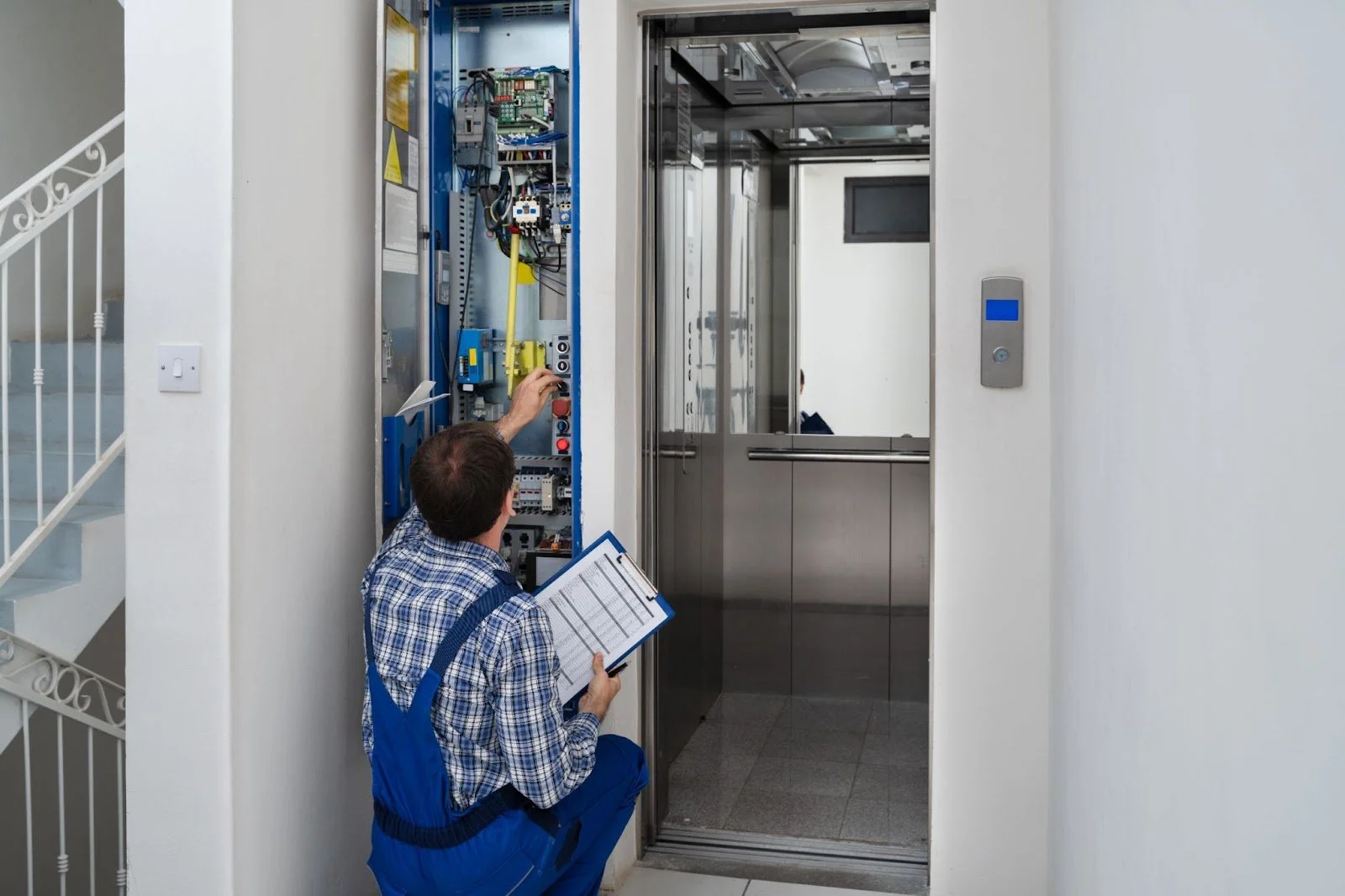Do I Need to Hire a Professional to Fix My Residential Elevator?
A properly functioning residential elevator ensures safety, accessibility, and convenience. It provides reliable mobility for everyone, especially those with limited movement, and adds value to multi-level homes.
However, elevators develop issues over time, such as malfunctioning doors, unusual noises, jerky movement, unresponsive controls, or complete breakdowns. Wear and tear, electrical problems, and poor maintenance often cause these issues.
You may feel tempted to attempt repairs yourself to save money or time, but is that the best approach? This blog explains when to hire a professional technician versus attempting DIY repairs, helping you make the safest and most effective choice.
Common residential elevator issues
Recognizing common issues helps you determine whether a simple fix will work or if you need professional assistance.
Mechanical malfunctions
Mechanical malfunctions often occur when cables, pulleys, or hydraulic systems fail. Damaged or misaligned cables cause jerky movement, sudden stops, or uneven floor alignment. Problems with pulleys or hydraulic systems compromise the elevator’s ability to lift and lower smoothly, posing serious safety risks.
Electrical issues
Electrical issues frequently disrupt elevator performance. Faulty wiring, malfunctioning control panels, or inconsistent power supplies cause elevators to stop mid-operation, respond poorly to commands, or refuse to start altogether. Electrical problems require immediate attention to prevent further damage and ensure safe operation.
Safety feature malfunctions
Safety feature malfunctions present a significant concern. Broken emergency brakes, malfunctioning door sensors, or faulty interlocks compromise user safety. When these critical components fail, the elevator may operate unpredictably or fail to detect obstacles, increasing the risk of accidents.
Wear and tear
Wear and tear gradually affects performance, especially in high-use residential elevators. Weather exposure, lack of maintenance, and daily use cause parts to degrade, leading to slower operation, grinding noises, or complete breakdowns. Regular maintenance helps prevent these issues, but neglecting it accelerates deterioration.
Understanding these common elevator problems allows you to address minor issues promptly and recognize when to seek professional help. Attempting DIY repairs on complex mechanical or electrical systems often leads to more harm than good. Knowing the signs of trouble ensures you maintain a safe, reliable elevator that enhances your home’s accessibility.
Risks of DIY elevator repairs
Attempting DIY repairs on a residential elevator may seem like a cost-saving solution, but it often leads to more harm than good. Without proper expertise, tools, or licensing, you risk compromising safety, violating codes, and voiding valuable warranties. Understanding these risks helps you make an informed decision when elevator issues arise.
Safety hazards pose the most immediate and dangerous threat. Residential elevators involve complex mechanical and electrical systems that require precise adjustments. Without proper training, you might easily cause further damage, create electrical hazards, or injure yourself during repairs. Mishandling cables, pulleys, or control panels turn a minor issue into a severe safety concern.
Code violations present another major risk of DIY repairs. Elevator installations and repairs must meet strict local, state, and federal safety codes. Attempting unlicensed repairs can result in costly fines, legal issues, or even the forced shutdown of your elevator. Compliance requires detailed knowledge of current regulations, which most homeowners lack.
Lack of proper tools and expertise often leads to ineffective or incomplete elevator repairs. Residential elevators use specialized parts and equipment that require precise handling. Using the wrong tools or techniques worsens the problem and creates future safety risks. Professional technicians have the training and resources necessary to diagnose and fix issues correctly the first time.
Voiding warranties adds yet another financial risk. Manufacturers typically require certified technicians to handle repairs and maintenance. Attempting DIY fixes often voids these warranties, leaving you responsible for expensive future repairs or replacements. Without warranty protection, a simple issue escalates into a costly ordeal.
Repairing a residential elevator without professional guidance often results in greater damage, higher costs, and increased safety risks. When problems arise, calling a certified technician ensures safe, efficient repairs that comply with regulations and protect your investment.
Benefits of hiring a professional elevator technician
Hiring a professional elevator technician offers numerous advantages that DIY repairs can’t match. From technical expertise to warranty protection, certified technicians provide comprehensive solutions that ensure safety, compliance, and long-term reliability.
Expert knowledge and experience set professional technicians apart from amateur attempts. Certified technicians possess extensive training in diagnosing and repairing complex elevator systems.
They understand how to address issues accurately, whether they involve mechanical components, electrical wiring, or safety features. Their expertise ensures efficient repairs that restore your elevator’s performance without unnecessary guesswork.
Compliance with safety codes remains essential for any elevator repair. Professional elevator technicians stay updated on local, state, and federal regulations, ensuring every repair meets legal standards. Maintaining full compliance throughout the repair process prevents costly fines or legal complications.
Access to specialized tools and parts gives professionals a significant advantage. Certified technicians use advanced diagnostic equipment and genuine replacement parts designed for your specific elevator model. Their tools and resources ensure high-quality repairs that last, reducing the likelihood of recurring issues.
Preserving warranties provides another critical benefit. Manufacturers often require certified technicians to perform repairs and maintenance to keep warranties valid. Hiring a professional protects your warranty coverage and avoids paying out-of-pocket for future problems.
Regular maintenance services from a qualified technician prevent major issues before they develop. Scheduled inspections and tune-ups enhance performance, boost safety, and extend your elevator’s lifespan. Preventative maintenance saves you money by addressing minor problems before they become costly repairs.
Hiring a professional technician ensures your elevator remains safe, compliant, and fully operational. Their expertise, tools, and maintenance services provide peace of mind, protecting your investment while enhancing the convenience and safety of your home.
Signs you need a professional repair
Recognizing when your residential elevator needs professional attention prevents costly damage and ensures safe operation. Ignoring warning signs often leads to more extensive repairs or dangerous malfunctions. Knowing what to watch for helps you act quickly and avoid unnecessary risks.
Unusual noises signal potential mechanical problems. Grinding, clanking, or squeaking sounds during operation often indicate issues with cables, pulleys, or gears. Worn or misaligned parts can compromise the elevator’s performance and create safety hazards if left unaddressed.
Jerky or slow movement suggests mechanical or hydraulic malfunctions. If the elevator struggles to move smoothly between floors or hesitates during operation, you likely have a problem with the motor, cables, or hydraulic system. Delayed responses or abrupt stops indicate deeper issues that require a technician’s expertise.
Non-responsive controls point to electrical failures. Buttons or control panels that don’t work properly can result from faulty wiring, damaged circuits, or power supply issues. Ignoring these problems can lead to complete system failure, leaving you stranded or unable to operate the elevator safely.
Frequent breakdowns indicate unresolved or worsening problems. If your elevator continues to malfunction despite repeated attempts to fix it, you likely need a certified technician to assess the underlying cause. Persistent issues often suggest mechanical wear, electrical faults, or poor maintenance.
Safety feature malfunctions create immediate risks. When door sensors, emergency brakes, or alarms fail to function correctly, the elevator no longer meets essential safety standards. Operating an elevator with compromised safety features endangers everyone who uses it.
Recognizing these signs and contacting a professional technician promptly protects your elevator’s functionality, safety, and longevity. Attempting to fix complex problems yourself often leads to further damage or injury. Trusting certified experts ensures reliable, compliant repairs that keep your elevator running smoothly.
Trust Salt Lake Stairlifts for expert, reliable service
Our certified technicians provide prompt, thorough repairs that restore safety, efficiency, and convenience. We ensure your elevator meets all safety codes, preserving your warranty and preventing costly future issues.
Contact Salt Lake Stairlifts today for professional repairs that keep your elevator running smoothly and safely.


